University World Religions Multiple Choice Quiz - Exam
VerifiedAdded on 2022/08/24
|7
|1177
|21
Quiz and Exam
AI Summary
This document presents a multiple-choice quiz designed to assess knowledge of various world religions. The quiz covers a range of topics including Hindu beliefs and practices such as dharma, karma, and the roles of deities, as well as the concepts of moksha and the caste system. It also explores Buddhism, focusing on the Four Noble Truths, the Eightfold Path, and the significance of the Sangha. Additionally, the quiz delves into African religions, examining their spiritual beliefs, the role of the Supreme Being, the importance of ancestors and spirits, and cultural practices such as initiation rites and healing rituals. The quiz also includes questions about the intersection of religion, culture, ethics, and nursing, and the application of religious concepts in healthcare settings. The quiz is a valuable tool for anyone seeking to understand and test their knowledge of different religious traditions.
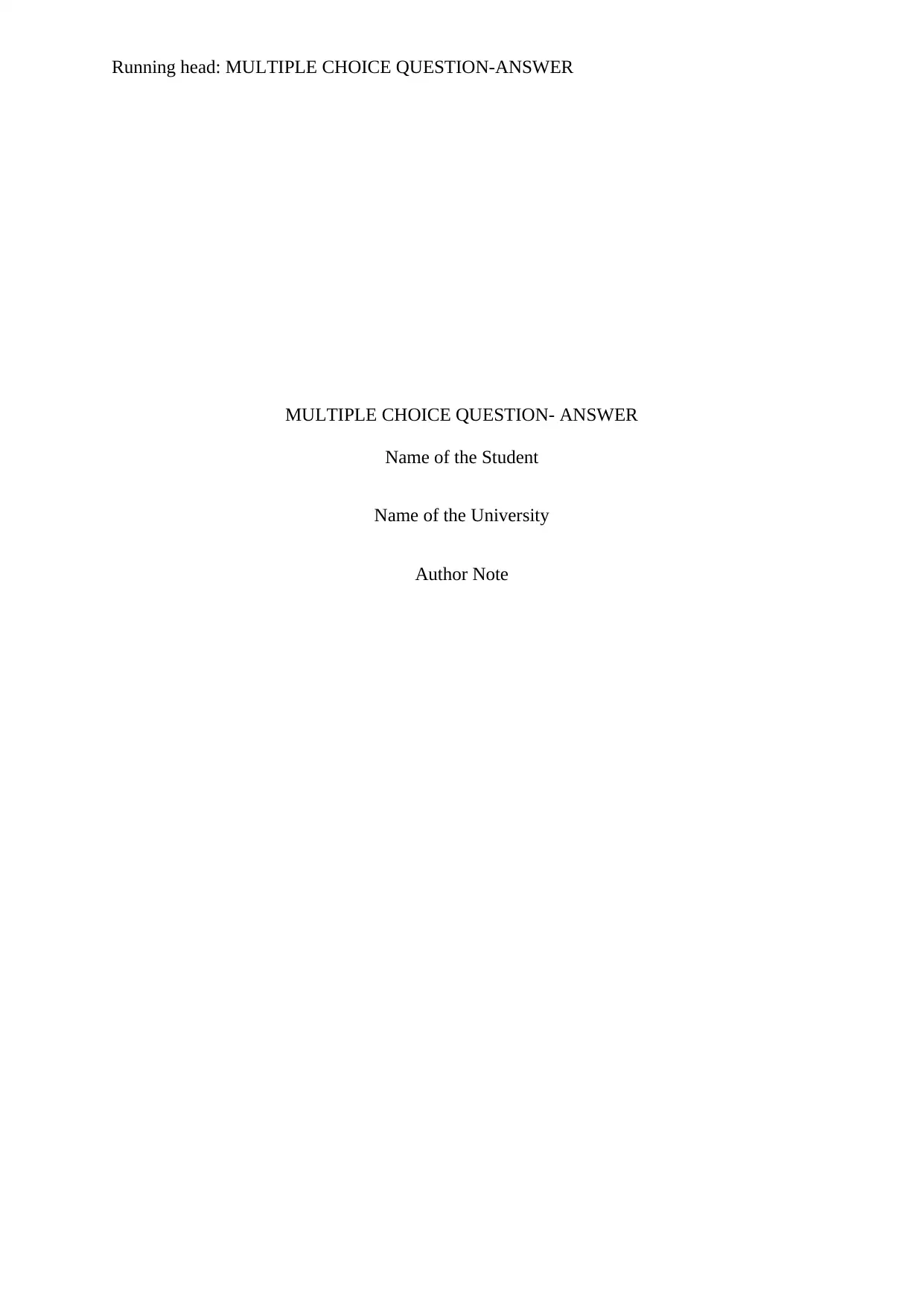
Running head: MULTIPLE CHOICE QUESTION-ANSWER
MULTIPLE CHOICE QUESTION- ANSWER
Name of the Student
Name of the University
Author Note
MULTIPLE CHOICE QUESTION- ANSWER
Name of the Student
Name of the University
Author Note
Paraphrase This Document
Need a fresh take? Get an instant paraphrase of this document with our AI Paraphraser
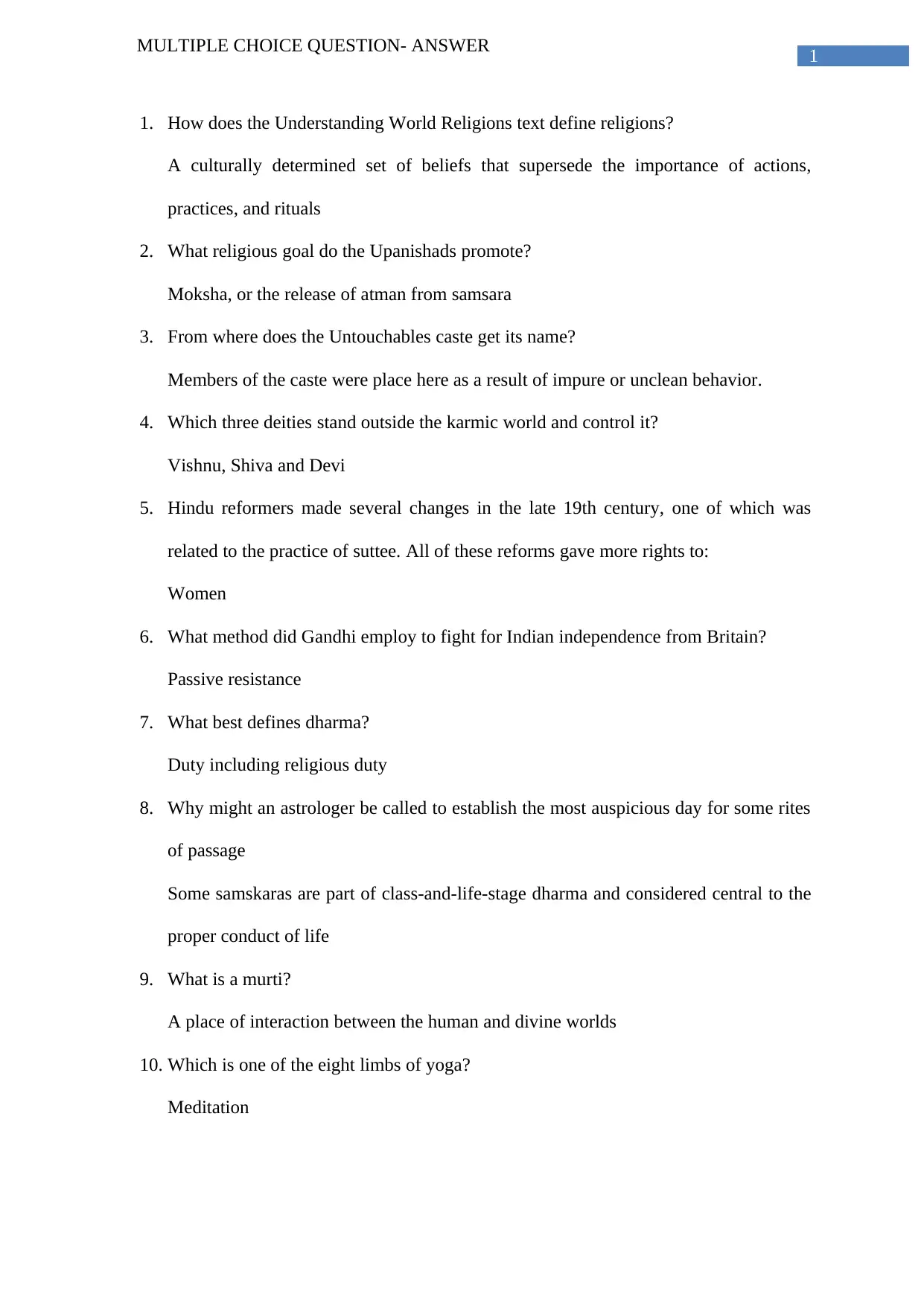
1
MULTIPLE CHOICE QUESTION- ANSWER
1. How does the Understanding World Religions text define religions?
A culturally determined set of beliefs that supersede the importance of actions,
practices, and rituals
2. What religious goal do the Upanishads promote?
Moksha, or the release of atman from samsara
3. From where does the Untouchables caste get its name?
Members of the caste were place here as a result of impure or unclean behavior.
4. Which three deities stand outside the karmic world and control it?
Vishnu, Shiva and Devi
5. Hindu reformers made several changes in the late 19th century, one of which was
related to the practice of suttee. All of these reforms gave more rights to:
Women
6. What method did Gandhi employ to fight for Indian independence from Britain?
Passive resistance
7. What best defines dharma?
Duty including religious duty
8. Why might an astrologer be called to establish the most auspicious day for some rites
of passage
Some samskaras are part of class-and-life-stage dharma and considered central to the
proper conduct of life
9. What is a murti?
A place of interaction between the human and divine worlds
10. Which is one of the eight limbs of yoga?
Meditation
MULTIPLE CHOICE QUESTION- ANSWER
1. How does the Understanding World Religions text define religions?
A culturally determined set of beliefs that supersede the importance of actions,
practices, and rituals
2. What religious goal do the Upanishads promote?
Moksha, or the release of atman from samsara
3. From where does the Untouchables caste get its name?
Members of the caste were place here as a result of impure or unclean behavior.
4. Which three deities stand outside the karmic world and control it?
Vishnu, Shiva and Devi
5. Hindu reformers made several changes in the late 19th century, one of which was
related to the practice of suttee. All of these reforms gave more rights to:
Women
6. What method did Gandhi employ to fight for Indian independence from Britain?
Passive resistance
7. What best defines dharma?
Duty including religious duty
8. Why might an astrologer be called to establish the most auspicious day for some rites
of passage
Some samskaras are part of class-and-life-stage dharma and considered central to the
proper conduct of life
9. What is a murti?
A place of interaction between the human and divine worlds
10. Which is one of the eight limbs of yoga?
Meditation
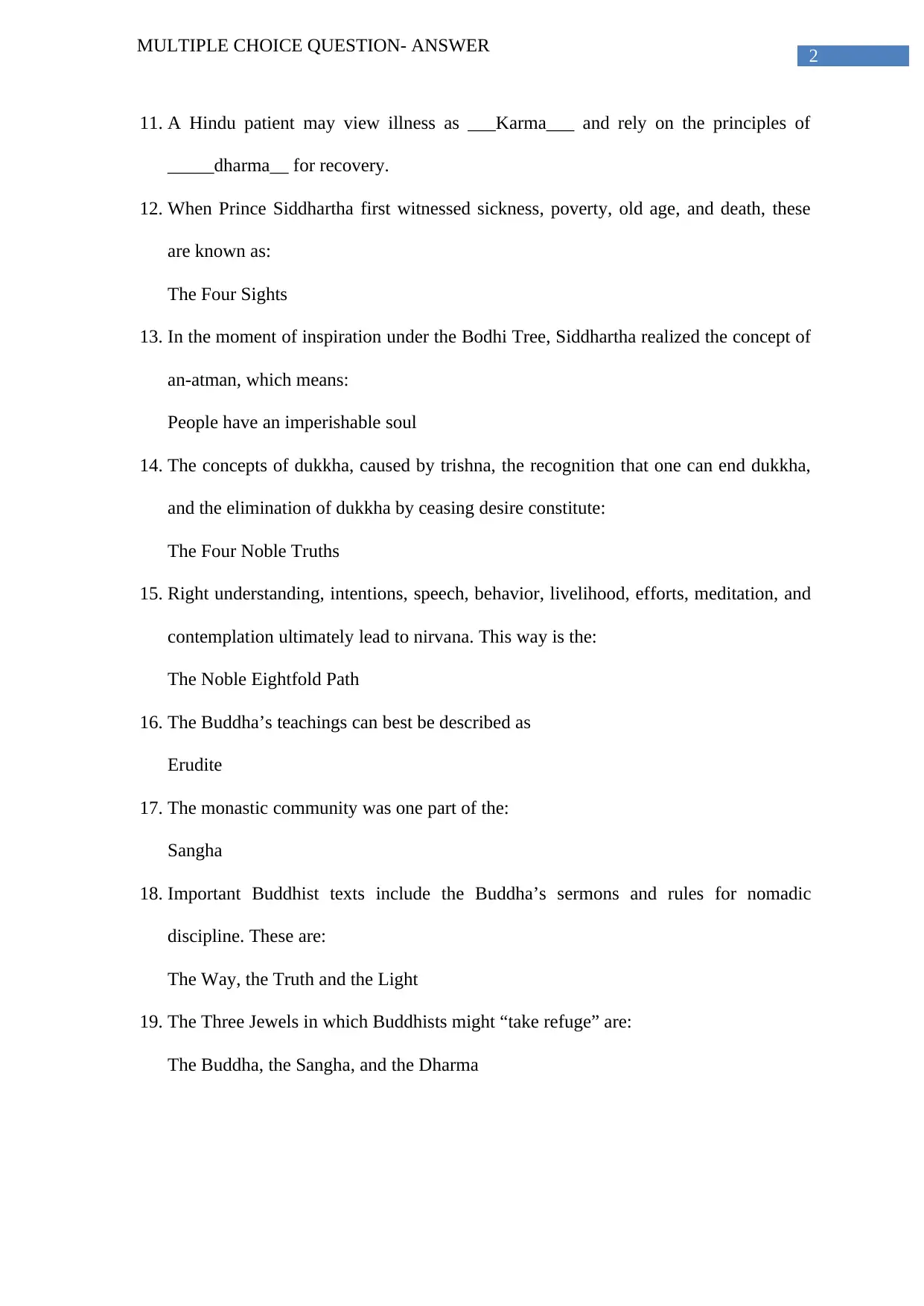
2
MULTIPLE CHOICE QUESTION- ANSWER
11. A Hindu patient may view illness as ___Karma___ and rely on the principles of
_____dharma__ for recovery.
12. When Prince Siddhartha first witnessed sickness, poverty, old age, and death, these
are known as:
The Four Sights
13. In the moment of inspiration under the Bodhi Tree, Siddhartha realized the concept of
an-atman, which means:
People have an imperishable soul
14. The concepts of dukkha, caused by trishna, the recognition that one can end dukkha,
and the elimination of dukkha by ceasing desire constitute:
The Four Noble Truths
15. Right understanding, intentions, speech, behavior, livelihood, efforts, meditation, and
contemplation ultimately lead to nirvana. This way is the:
The Noble Eightfold Path
16. The Buddha’s teachings can best be described as
Erudite
17. The monastic community was one part of the:
Sangha
18. Important Buddhist texts include the Buddha’s sermons and rules for nomadic
discipline. These are:
The Way, the Truth and the Light
19. The Three Jewels in which Buddhists might “take refuge” are:
The Buddha, the Sangha, and the Dharma
MULTIPLE CHOICE QUESTION- ANSWER
11. A Hindu patient may view illness as ___Karma___ and rely on the principles of
_____dharma__ for recovery.
12. When Prince Siddhartha first witnessed sickness, poverty, old age, and death, these
are known as:
The Four Sights
13. In the moment of inspiration under the Bodhi Tree, Siddhartha realized the concept of
an-atman, which means:
People have an imperishable soul
14. The concepts of dukkha, caused by trishna, the recognition that one can end dukkha,
and the elimination of dukkha by ceasing desire constitute:
The Four Noble Truths
15. Right understanding, intentions, speech, behavior, livelihood, efforts, meditation, and
contemplation ultimately lead to nirvana. This way is the:
The Noble Eightfold Path
16. The Buddha’s teachings can best be described as
Erudite
17. The monastic community was one part of the:
Sangha
18. Important Buddhist texts include the Buddha’s sermons and rules for nomadic
discipline. These are:
The Way, the Truth and the Light
19. The Three Jewels in which Buddhists might “take refuge” are:
The Buddha, the Sangha, and the Dharma
⊘ This is a preview!⊘
Do you want full access?
Subscribe today to unlock all pages.

Trusted by 1+ million students worldwide
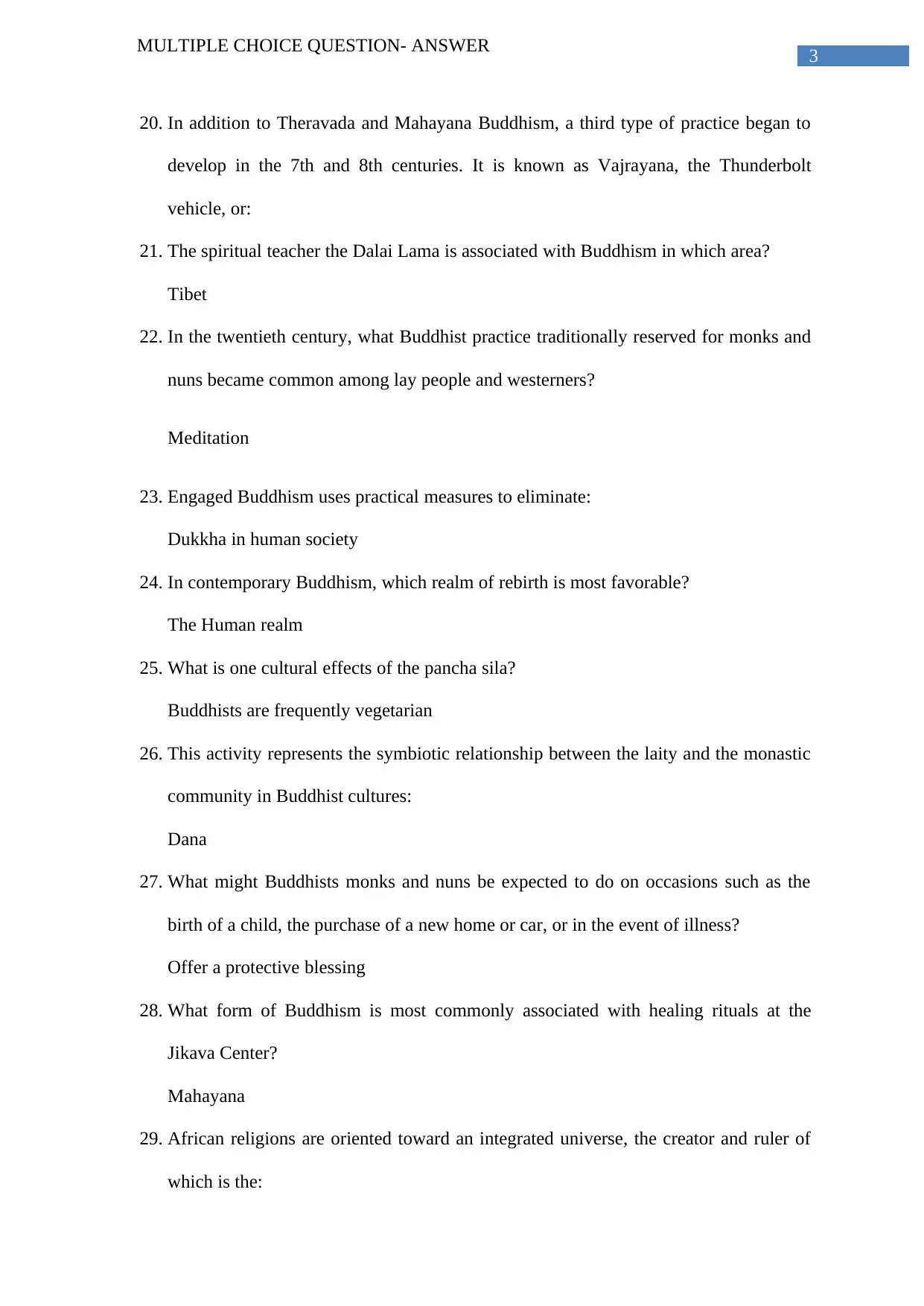
3
MULTIPLE CHOICE QUESTION- ANSWER
20. In addition to Theravada and Mahayana Buddhism, a third type of practice began to
develop in the 7th and 8th centuries. It is known as Vajrayana, the Thunderbolt
vehicle, or:
21. The spiritual teacher the Dalai Lama is associated with Buddhism in which area?
Tibet
22. In the twentieth century, what Buddhist practice traditionally reserved for monks and
nuns became common among lay people and westerners?
Meditation
23. Engaged Buddhism uses practical measures to eliminate:
Dukkha in human society
24. In contemporary Buddhism, which realm of rebirth is most favorable?
The Human realm
25. What is one cultural effects of the pancha sila?
Buddhists are frequently vegetarian
26. This activity represents the symbiotic relationship between the laity and the monastic
community in Buddhist cultures:
Dana
27. What might Buddhists monks and nuns be expected to do on occasions such as the
birth of a child, the purchase of a new home or car, or in the event of illness?
Offer a protective blessing
28. What form of Buddhism is most commonly associated with healing rituals at the
Jikava Center?
Mahayana
29. African religions are oriented toward an integrated universe, the creator and ruler of
which is the:
MULTIPLE CHOICE QUESTION- ANSWER
20. In addition to Theravada and Mahayana Buddhism, a third type of practice began to
develop in the 7th and 8th centuries. It is known as Vajrayana, the Thunderbolt
vehicle, or:
21. The spiritual teacher the Dalai Lama is associated with Buddhism in which area?
Tibet
22. In the twentieth century, what Buddhist practice traditionally reserved for monks and
nuns became common among lay people and westerners?
Meditation
23. Engaged Buddhism uses practical measures to eliminate:
Dukkha in human society
24. In contemporary Buddhism, which realm of rebirth is most favorable?
The Human realm
25. What is one cultural effects of the pancha sila?
Buddhists are frequently vegetarian
26. This activity represents the symbiotic relationship between the laity and the monastic
community in Buddhist cultures:
Dana
27. What might Buddhists monks and nuns be expected to do on occasions such as the
birth of a child, the purchase of a new home or car, or in the event of illness?
Offer a protective blessing
28. What form of Buddhism is most commonly associated with healing rituals at the
Jikava Center?
Mahayana
29. African religions are oriented toward an integrated universe, the creator and ruler of
which is the:
Paraphrase This Document
Need a fresh take? Get an instant paraphrase of this document with our AI Paraphraser
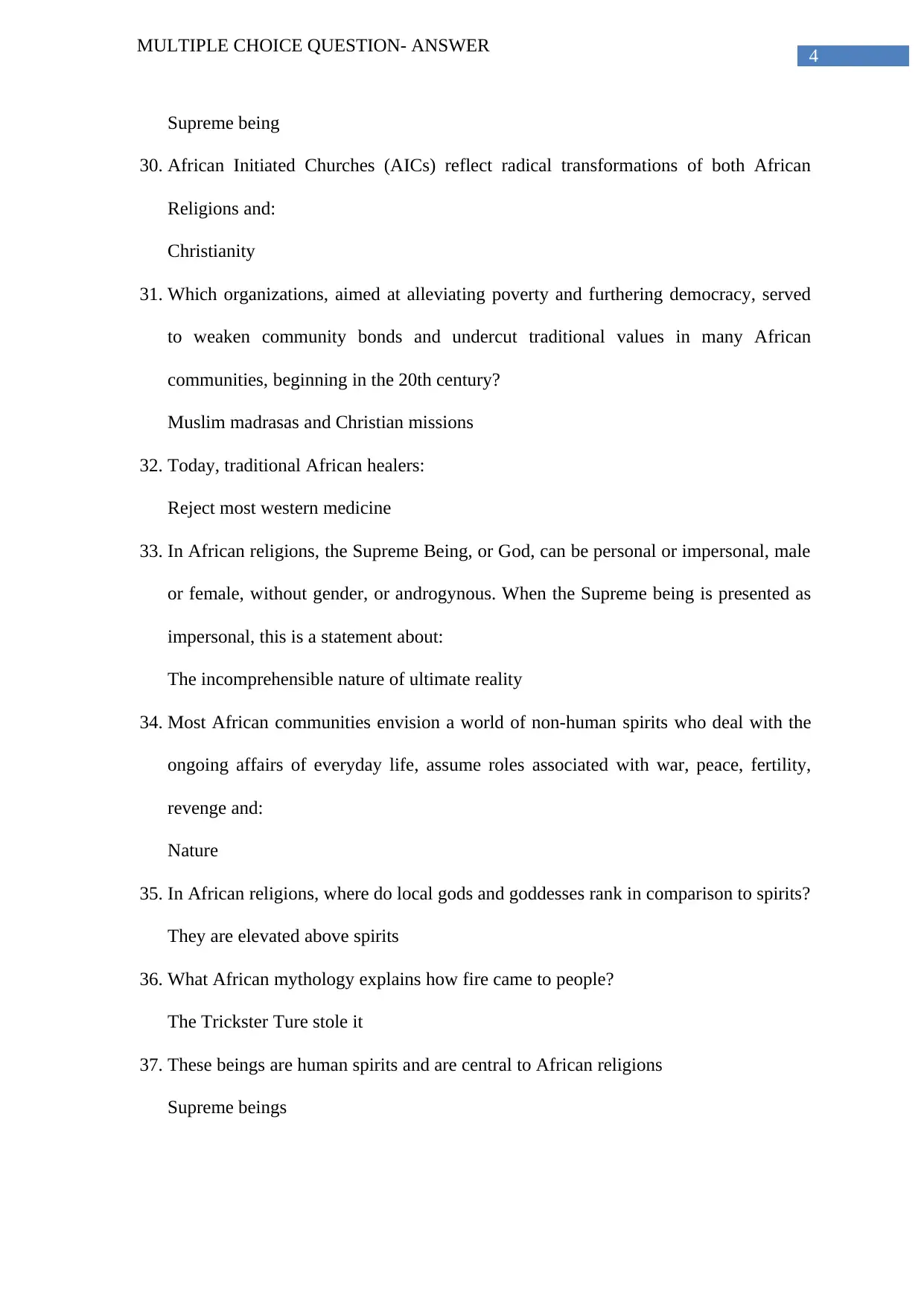
4
MULTIPLE CHOICE QUESTION- ANSWER
Supreme being
30. African Initiated Churches (AICs) reflect radical transformations of both African
Religions and:
Christianity
31. Which organizations, aimed at alleviating poverty and furthering democracy, served
to weaken community bonds and undercut traditional values in many African
communities, beginning in the 20th century?
Muslim madrasas and Christian missions
32. Today, traditional African healers:
Reject most western medicine
33. In African religions, the Supreme Being, or God, can be personal or impersonal, male
or female, without gender, or androgynous. When the Supreme being is presented as
impersonal, this is a statement about:
The incomprehensible nature of ultimate reality
34. Most African communities envision a world of non-human spirits who deal with the
ongoing affairs of everyday life, assume roles associated with war, peace, fertility,
revenge and:
Nature
35. In African religions, where do local gods and goddesses rank in comparison to spirits?
They are elevated above spirits
36. What African mythology explains how fire came to people?
The Trickster Ture stole it
37. These beings are human spirits and are central to African religions
Supreme beings
MULTIPLE CHOICE QUESTION- ANSWER
Supreme being
30. African Initiated Churches (AICs) reflect radical transformations of both African
Religions and:
Christianity
31. Which organizations, aimed at alleviating poverty and furthering democracy, served
to weaken community bonds and undercut traditional values in many African
communities, beginning in the 20th century?
Muslim madrasas and Christian missions
32. Today, traditional African healers:
Reject most western medicine
33. In African religions, the Supreme Being, or God, can be personal or impersonal, male
or female, without gender, or androgynous. When the Supreme being is presented as
impersonal, this is a statement about:
The incomprehensible nature of ultimate reality
34. Most African communities envision a world of non-human spirits who deal with the
ongoing affairs of everyday life, assume roles associated with war, peace, fertility,
revenge and:
Nature
35. In African religions, where do local gods and goddesses rank in comparison to spirits?
They are elevated above spirits
36. What African mythology explains how fire came to people?
The Trickster Ture stole it
37. These beings are human spirits and are central to African religions
Supreme beings
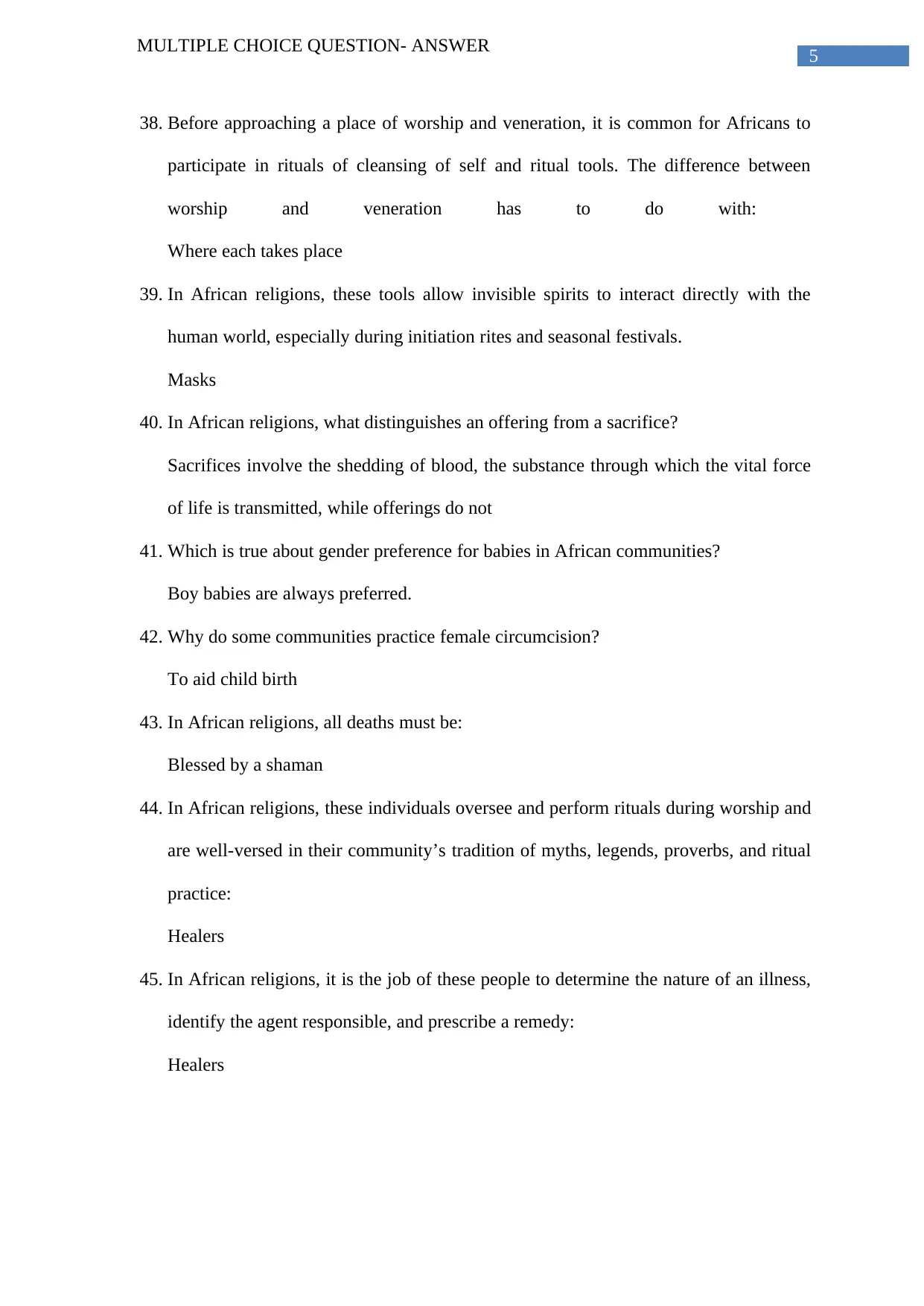
5
MULTIPLE CHOICE QUESTION- ANSWER
38. Before approaching a place of worship and veneration, it is common for Africans to
participate in rituals of cleansing of self and ritual tools. The difference between
worship and veneration has to do with:
Where each takes place
39. In African religions, these tools allow invisible spirits to interact directly with the
human world, especially during initiation rites and seasonal festivals.
Masks
40. In African religions, what distinguishes an offering from a sacrifice?
Sacrifices involve the shedding of blood, the substance through which the vital force
of life is transmitted, while offerings do not
41. Which is true about gender preference for babies in African communities?
Boy babies are always preferred.
42. Why do some communities practice female circumcision?
To aid child birth
43. In African religions, all deaths must be:
Blessed by a shaman
44. In African religions, these individuals oversee and perform rituals during worship and
are well-versed in their community’s tradition of myths, legends, proverbs, and ritual
practice:
Healers
45. In African religions, it is the job of these people to determine the nature of an illness,
identify the agent responsible, and prescribe a remedy:
Healers
MULTIPLE CHOICE QUESTION- ANSWER
38. Before approaching a place of worship and veneration, it is common for Africans to
participate in rituals of cleansing of self and ritual tools. The difference between
worship and veneration has to do with:
Where each takes place
39. In African religions, these tools allow invisible spirits to interact directly with the
human world, especially during initiation rites and seasonal festivals.
Masks
40. In African religions, what distinguishes an offering from a sacrifice?
Sacrifices involve the shedding of blood, the substance through which the vital force
of life is transmitted, while offerings do not
41. Which is true about gender preference for babies in African communities?
Boy babies are always preferred.
42. Why do some communities practice female circumcision?
To aid child birth
43. In African religions, all deaths must be:
Blessed by a shaman
44. In African religions, these individuals oversee and perform rituals during worship and
are well-versed in their community’s tradition of myths, legends, proverbs, and ritual
practice:
Healers
45. In African religions, it is the job of these people to determine the nature of an illness,
identify the agent responsible, and prescribe a remedy:
Healers
⊘ This is a preview!⊘
Do you want full access?
Subscribe today to unlock all pages.

Trusted by 1+ million students worldwide
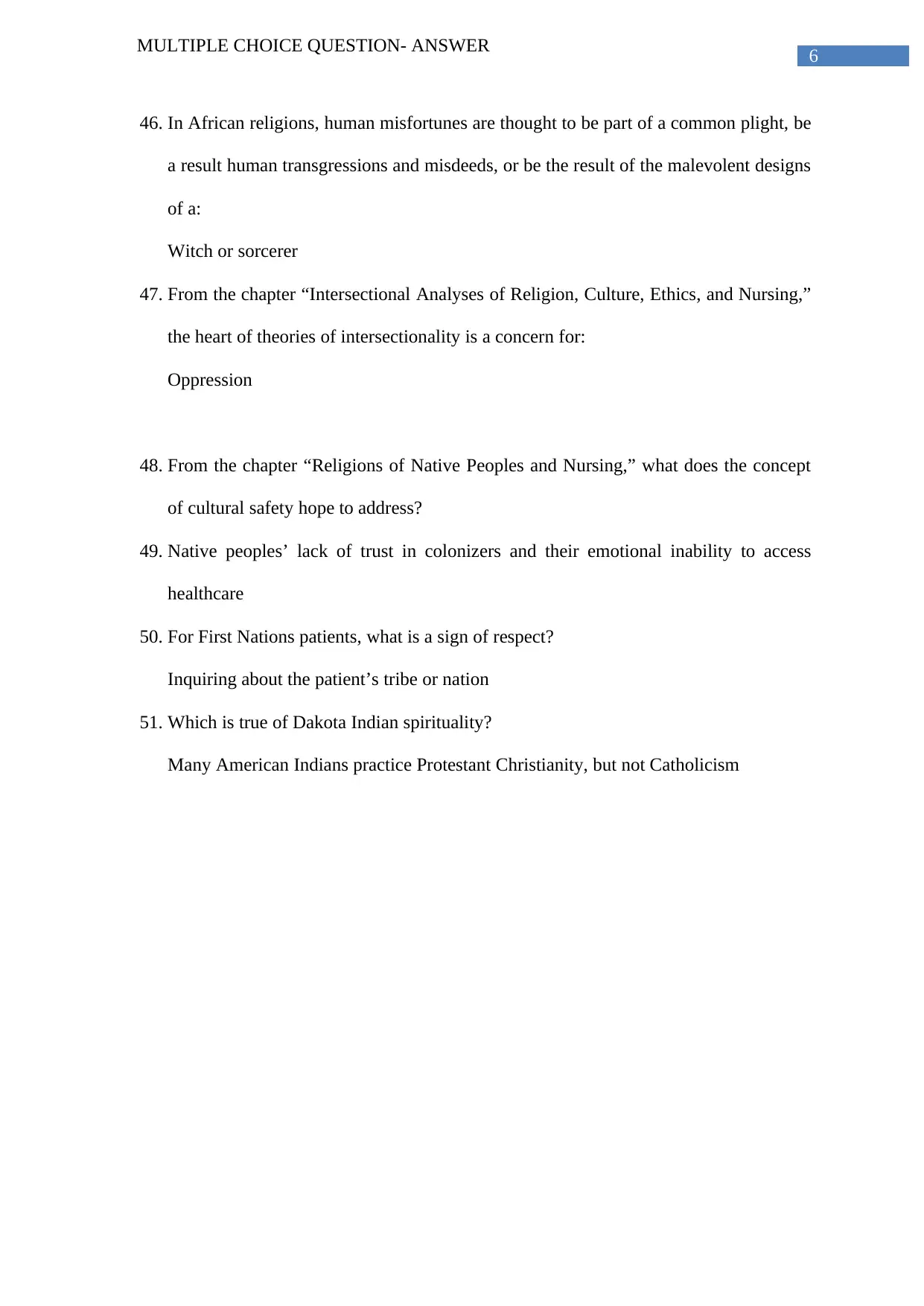
6
MULTIPLE CHOICE QUESTION- ANSWER
46. In African religions, human misfortunes are thought to be part of a common plight, be
a result human transgressions and misdeeds, or be the result of the malevolent designs
of a:
Witch or sorcerer
47. From the chapter “Intersectional Analyses of Religion, Culture, Ethics, and Nursing,”
the heart of theories of intersectionality is a concern for:
Oppression
48. From the chapter “Religions of Native Peoples and Nursing,” what does the concept
of cultural safety hope to address?
49. Native peoples’ lack of trust in colonizers and their emotional inability to access
healthcare
50. For First Nations patients, what is a sign of respect?
Inquiring about the patient’s tribe or nation
51. Which is true of Dakota Indian spirituality?
Many American Indians practice Protestant Christianity, but not Catholicism
MULTIPLE CHOICE QUESTION- ANSWER
46. In African religions, human misfortunes are thought to be part of a common plight, be
a result human transgressions and misdeeds, or be the result of the malevolent designs
of a:
Witch or sorcerer
47. From the chapter “Intersectional Analyses of Religion, Culture, Ethics, and Nursing,”
the heart of theories of intersectionality is a concern for:
Oppression
48. From the chapter “Religions of Native Peoples and Nursing,” what does the concept
of cultural safety hope to address?
49. Native peoples’ lack of trust in colonizers and their emotional inability to access
healthcare
50. For First Nations patients, what is a sign of respect?
Inquiring about the patient’s tribe or nation
51. Which is true of Dakota Indian spirituality?
Many American Indians practice Protestant Christianity, but not Catholicism
1 out of 7
Your All-in-One AI-Powered Toolkit for Academic Success.
+13062052269
info@desklib.com
Available 24*7 on WhatsApp / Email
![[object Object]](/_next/static/media/star-bottom.7253800d.svg)
Unlock your academic potential
Copyright © 2020–2025 A2Z Services. All Rights Reserved. Developed and managed by ZUCOL.

